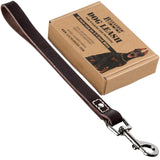Woof Woof Woof! The sound of home. The sound of your best friend.
As much as we love the greeting from our best friend, sometimes it brings us to problems with our neighbours or disturbs the kids that are studying in the next room, or simply starts to be annoying (yes, you know what am I talking about). And today's article we would like to present you the ways on how to deal with that kind of behaviour and how to teach your dog to behave nicely.
But, before we jump in the topic. Please consider joining our Loyalty Club (simply by providing your email address in the bottom right pop up icon). Why would you do that? Because every month this year, on the last day of the month, we randomly select one of our Loyalty Members and send them a Leatherberg gift (leather dog leash, or traffic leash or maybe a dog collar).
Also, feel free to check out our new Facebook Group - Dog Training & Caring, where we are creating a hub of valuable information given by professionals from multiple pet-related fields like - dog trainers, vets, dog rescue organizations, dog product manufacturers etc.
Now, back to business.
10 million Google searches?
Communication is the key
Anyone who owns a dog or puppy will eventually run into the need to eliminate unwanted habits. While most dogs are eager to please their owners and smart enough to do what is asked of them, it is important for the owner to properly communicate just what constitutes acceptable and unacceptable behaviours.

Howling and Whining
Some tips of dealing with excessive whining, barking and howling include:
- If your puppy or dog is howling or whining while confined to its crate, immediately take it to its toilet area. Most puppies and dogs will whine when they need to do their business.
- It is important to teach a dog or a puppy to accept being alone. Many dogs suffer from separation anxiety, and these stressed dogs can exhibit all sorts of destructive and annoying behaviours. It is important to accustom the puppy to being left on its own, even when the owner is at home.
-
Always strive to make the puppy or dog as comfortable as possible. Always attend to the physical and psychological needs of the dog by providing food, water and toys.
-
If the dog is whining, check for obvious reasons first. Is the water dish empty? Is the dog showing signs of illness? Has his or her favourite toy rolled under the furniture? Is the temperature of the room too hot or too cold?
-
Do not reward the puppy or dog for whining. If the dog whines when left alone, for instance, it would be a mistake to go to the dog every time it whines.
I wanna give you more options, more techniques to choose from.
-
The Technique
So, a gentle way to quiet gentle natured dogs is to first noticeably pay attention to what they are barking at, so that they understand that you have seen it, then give at least verbal, if not also physical, praise (for example 'good boy' or 'good girl' and a pat or a stroke). This will acknowledge that the message has been received, understood and 'shouting' is no longer required.
If the barking continues, while praising and stroking or otherwise giving physical affection, very gently take hold of the muzzle and hold the mouth closed - gently.
Please remember that many dogs may find it provocative when you bend over them, especially when they are barking aggressively - so if in doubt and you need to bend to reach your dog, it is best to do it to the side of the dog otherwise you might find yourself causing an escalation to aggressive behaviour.
The point of the exercise in dog language is that having brought whatever it was to our attention and passed on the responsibility of dealing with it, they can return to their natural state of being calm and looking to you for leadership.
*****
This is just a snapshot... if you want to know more or have any questions about how to deal with a dog that barks when you'd rather they didn't, please get in touch.

Generally, there are eight reasons why dogs bark:
- Territorial or defensive barking
- Excitement, or happiness at seeing you
- Play and exercise
- To get your attention or to signal you (i.e. "I have to go potty!")
- Aggravation of not being able to attain something (such as your pork chop).
- Social barking in response to other dogs
- Separation anxiety and trepidation
- Compulsive behaviour
A List of Don'ts:
- Don't encourage your dog to bark at strangers or people walking by the door. Asking your dog "who's that?" in a querying tone will excite their curiosity. Looking out the window or door will encourage him to do the same, and once there, he will bark.
- Don't use inconsistent rules. If you yell at him for barking at some sights or sounds, such as the kids leaving for school, and encourage him to bark at others, like the salesman at the door, he will be hard-put to distinguish between the two events. The result will be a still-constantly barking dog.
- Don't punish your dog if the barking due to fright or separation anxiety. You may have the opposite effect of increasing his anxiety, and therefore, his barking. A Certified Applied Animal Behaviorist or Veterinary Behaviorist can give you specific directions for correcting this b
- Don't use a muzzle or HusherTM as a substitute for training, or while you are absent. Your dog regulates his temperature through the mouth by panting and muzzles prevent your dog from doing this as well as drinking water and eating.
- Don't attempt to make your own muzzle using rope or rubber bands. Not only is it cruel, it can be dangerous for the dog.
Please note that there are instances of excessive barking for which it is a good idea to seek the advice of a Certified Applied Animal Behaviorist, a Veterinary Behaviorist, or a Certified Professional Dog Trainer, like our friend Ted Carlson, first.
These include:
- Over-protective behaviour in addition to the barking, such as growling, snapping, lunging, etc.
- Extreme separation anxiety or fear of objects, sights, sounds, people etc.
- Obsessive/Compulsive barking which is identified as excessive barking for no apparent reason or at things that wouldn't bother other dogs. This may be accompanied by other compulsive behaviours such as spinning or jumping.
Territorial or Defensive Barking
This barking response is also known as alarm barking. It can be in response to people coming to the door, people or animals walking by your house, or other sights and sounds that alert the dog to the presence of someone or something crossing their territory. Territory can be your house, your yard, or even your car while you are driving.
You should be able to tell from your dog's body language and behaviour whether he's barking to say "Oh, boy! Visitors! I love visitors!" or "You best be moseying along!" The first example is a greeting bark, covered later in this article. If your dog seems to display more aggressive-behaviour he believes he is protecting his territory and/or defending you and your family from intruders.
In order to reduce this type of defensive barking, success depends on your dog associating strangers at the door and passersby with positive things like treats, praise and attention.
Training Options
To start, you can remove any stimulus from the dog's environment.
- Block your dog's access to doors and windows while he is indoors so he cannot see outside.
- Play music or the TV to mask noises that trigger barking.
- Change your doorbell ring so as to disassociate him from the ring he is used to accompanying with barking.
- Call him inside from the yard at times he is prone to barking, such as when school lets out and kids are noisily making their way home.
If the dog continues to bark after you have taken these steps, it is time for some counter-training.

Counter-Bark Training Method #1:
Counter-Bark Training Method #2:
If Method #1 isn't working after at least 10-20 sessions, add a startling noise to the "quiet" command, such as a can of pennies, a bell, even a loud single clap of your hands. This should gain his attention and you can then go through the remaining steps of calling him over, asking him to sit, and giving praise and treats until the person or noise is gone. If he begins barking immediately after you release him, repeat the steps. If after 10-20 more tries the barking hasn't diminished you may have an obsessive or anxiety situation and should seek the advice of a professional.
Counter-Bark Training Method #3:
All three of these methods are designed to condition the dog that people outside are associated with good things--treats, praise, attention.
If you have problems with your dog barking while riding in the car, you must enforce stillness and/or movement restriction. This is also good for the safety of both you and your dog. A loose, excited dog in a car is a distraction and can be trouble waiting to happen.
Place your dog in a travel crate which restricts both movement and his vision of the outside distractions. Use a seat belt safety lead if you can't use a crate. Begin training good car manners by making your dog sit and wait before jumping in the car. Play the radio to distract from outside noises.
Greeting barking
While barking at people outside or at the door (including you and your family), if your dog is also wagging his tail, crying, and jumping, this is a greeting bark and must be handled differently than territorial barking. Greeting barks are friendly, but can still be annoying to you and your neighbours. Here are a few tips to help control the barking.
Counter-bark techniques:
- Try to keep meeting and greeting under control. When you or a family member comes home, ignore your dog for the first couple minutes. When people come to the door, teach your dog to sit and wait until the person comes to him; this will bring control and anticipation to the greeting rather than barking.
- Keep one of his favourite toys by the door and train your dog to pick it up when a guest comes. He will be less likely to bark with a toy in his mouth.
- When walking, a "sit/stay" command until people pass will help. The command "wait" is good for gaining his attention and control.

Play barking
You don't want to discourage your dog from playing, but play barking can get annoying at times. If you have more than one dog and they bark when playing together, build a set routine of times and places where it is okay. When you are playing with your dog, encourage the use of toy-based games to decrease the amount of barking.
Attention seeking or request barking
This type of barking is a form of expression which often developed through positive reinforcement from the owner. If your dog barks to let you know he needs to go relieve himself, this is usually a good thing. When he barks because he wants your dinner or to play or go for a walk, this is less positive.
However, it's unlikely that he became a noisy, insistent pest on his own; your family likely had a hand in this during his upbringing. For example, perhaps you thought it was cute when he barked at you while you were cooking chicken and you slipped a piece to him. Dogs are pretty good associative learners and if they make the connection that barking equals food, they won't stop just because you no longer find it cute.
Excitement or frustration barking
Many dogs bark when they get excited or when they are frustrated by an inability to get at or do something. For example, the dog who runs through the backyard barking and whining when he hears his buddy out in the yard next door, or the dog who barks at the ball that rolled under the sofa a bit too far for him to get.
The best way to reduce excitement/frustration barking is through basic and intermediate obedience training. "Sit/stay" and "down/stay" are commands that say to your dog he must wait until you release him to go play, for a walk, or to meet his buddy. Animal intruders, such as cats or squirrels can be curtailed using motion-activated devices or other forms of discouragement.
Social barking
One tool that may help with this training is a head halter. It looks somewhat like a combination collar/muzzle, but it allows the dog to breath and drink. Used with supervision (never leave it on the dog when he is alone), it may have a controlling and calming effect on your walks and at home, reducing the likelihood of barking. A head halter does not replace training, rewards and praise, but is a tool to help you in your counter-bark training.
Anti-bark collars and your dogAnti-bark collars are punishment devices that shock, make an ultrasonic noise, or spray citronella when a dog barks. They are not good first choices for solving barking problems, especially when the barking is based on fear, anxiety or compulsion. Before using an anti-bark collar, you should consult with a Certified Applied Animal Behaviorist, a Veterinary Behaviorist, or a Certified Professional Dog Trainer.
Studies have shown that the collars that make a noise do not work with most dogs. One study compared the citronella spray collar and the electronic shock collar and found they are equally effective for eliminating barking. Some collars use a microphone to hear the dog's bark. If you have more than one dog, the second one could set off the collar with his barking. Anti-bark collars are not designed to be left on all the time and your dog may learn not to bark when the collar is on, and then resume the barking when the collar is off.(Source: Adapted from the ASPCA)
Cesar's best tips to stop dog barking
1. Correct dog problem behaviour and follow through.
2. Stay calm when trying to stop dog barking
Constant barking can be irritating, but you won't be able to correct the dog behaviour problem if you are frustrated. Animals don't follow unbalanced leaders. In fact, your dog will mirror your energy. If you're frustrated, he will be, too! And barking is a great release for that frustrated energy. Take a moment to curb your own internal barking first.
3. Stake your claim to stop the barking
Is your dog barking over and over again at the same object, person, situation, or place? Then you need to step up and claim that stimulus as your own. Use your body, your mind, and your calm-assertive energy to create an invisible wall that your dog is not allowed to cross. Do it with 100% dedication and focus, and the results may surprise you.
4. Stop the barking by challenging your dog mentally and physically
Excessive barking is often the result of pent-up energy. If this is the case, the solution is simple: release that energy in more productive ways. Does your dog receive a daily walk? Can you make the walk more challenging with a bicycle, a backpack, or by walking on an incline? Can you provide more mental challenges, such as herding, agility training, or simple obedience games? There are many, many ways to increase the challenges in your dog's life. Find one that you enjoy that your dog can participate in safely.

5. Get professional help to stop dog barking.
" Information without execution never gets any real results."















